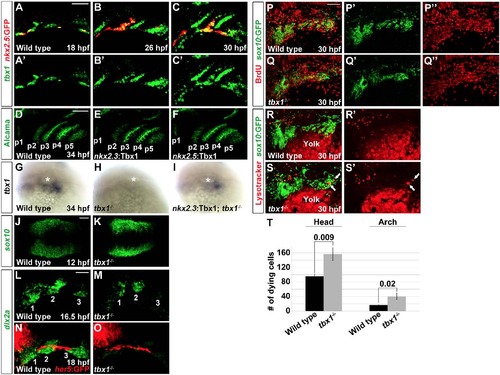
Mesodermal tbx1 expression during pouch formation and a requirement for Tbx1 in ectomesenchyme development
(A-C) Fluorescent in situ hybridization shows expression of tbx1 (green) in nkx2.5:GFP+ mesoderm labeled by GFP immunohistochemistry (red), as well as in nkx2.5:GFP- endoderm. Anterior is to the left and ventral is down. Scale bar represents 20 μM.
(D-F) Alcama immunohistochemistry on 34 hpf embryos. Transgenic expression of Tbx1 in the endoderm or mesoderm of nkx2.3:Tbx1 or nkx2.5:Tbx1 embryos, respectively, does not affect pouch development.
(G-I) In situ hybridization for tbx1 (dark blue) in 34 hpf embryos. In 31/31 wild-type siblings, tbx1 expression is observed in the pharyngeal region ventral to the ear (asterisk). In 8/8 tbx1 mutant siblings, all tbx1 expression is lost. In 11/11 nkx2.3:Tbx1; tbx1-/- embryos, tbx1 expression is partially restored to the pharyngeal region, particularly posterior to the ear.
(J and K) Fluorescent in situ hybridization for sox10 (green) at 12 hpf. Dorsal views with anterior to the left show sox10 expression in two bilateral fields of neural crest cells in both wild types and tbx1 mutants. We also note that sox10 expression was consistently higher in tbx1 mutants.
(L-O) Fluorescent in situ hybridization for dlx2a (green) to detect neural-crest-derived ectomesenchyme. While dlx2a is expressed in three distinct neural crest streams in 11/11 wild-type siblings at 16.5 hpf, its expression is reduced in the first and second streams and nearly lost in the third stream in 3/5 tbx1 mutants. Compared to wild-type siblings at 18 hpf (n=21), the arch expression of dlx2a was greatly reduced in 4/4 tbx1 mutants. her5:GFP labeling of endoderm at 18 hpf (red) shows that pouches have yet to form at this stage. Scale bar represents 40 μM.
(P and Q) BrdU staining (red) labels mitotic cells, and sox10:GFP (green) labels neural-crest-derived ectomesenchyme cells of the pharyngeal arches. Comparable numbers of BrdU+ cells were observed in wild-type siblings (n=4) and tbx1 mutants (n=4) at 30 hpf. Scale bar represents 40 μM. (R and S) Lysotracker Red staining (red) labels dying cells relative to sox10:GFP+ neural-crest-derived cells (green) in wild-type siblings (n=6) and tbx1 mutants (n=6). Arrows show dying cells in the posterior-most pharyngeal arches of a tbx1 mutant.
(T) Quantification of cell death in tbx1 mutants. Dying cells were counted in the entire head (from the posterior-most arch to the anterior limit of the embryo, including the brain, arches, and other tissues), as well as in sox10:GFP+ cells of the arches. A one-tailed Student?s t test with unequal variance was utilized to quantify the number of dying cells, and p values are shown.
|

